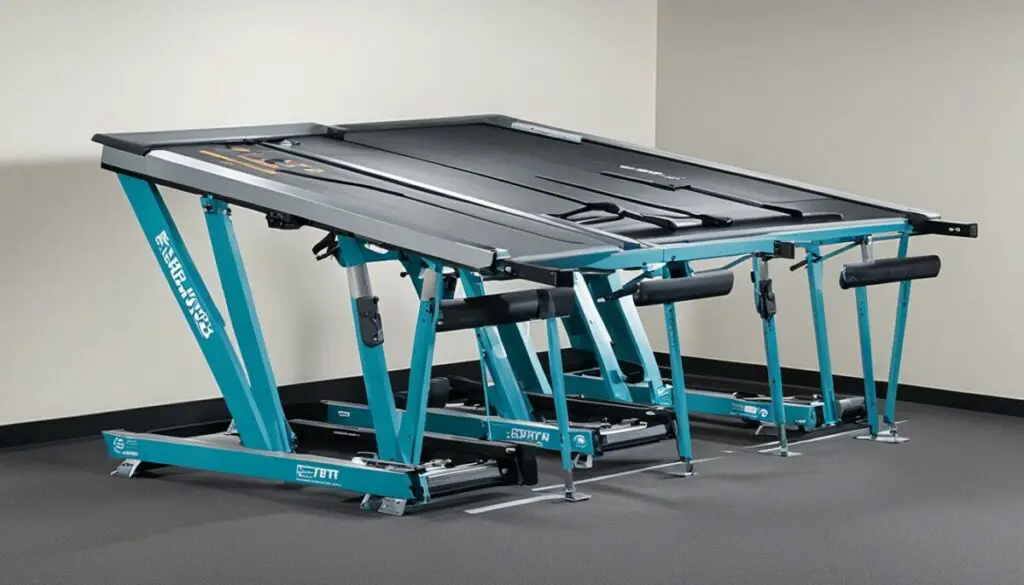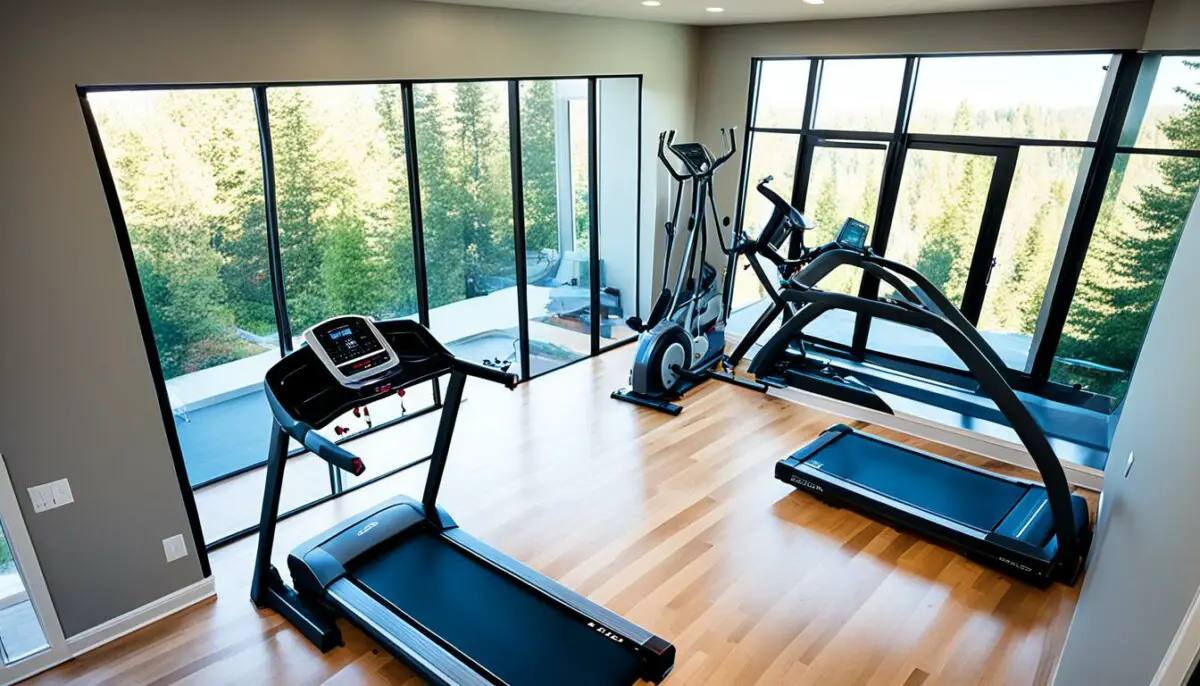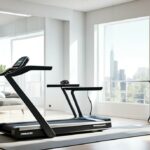Last Updated on 3 months by Francis
Installing a treadmill upstairs can provide a convenient fitness solution for individuals with limited space or a preference for privacy. However, it’s important to consider various factors before proceeding with the installation to ensure safety and efficiency.
When considering installing a treadmill upstairs, there are several important tips and considerations to keep in mind. Taking these into account will help you make an informed decision and ensure a successful installation.
Contents
Key Takeaways:
- Consider the structural requirements and weight capacity of your floor before installing a treadmill upstairs.
- Ensure that your floor is capable of supporting the weight of the treadmill and user without compromising its integrity.
- Take necessary measures to minimize noise and vibrations that may disturb others in the building, such as using anti-vibration mats or carpeted flooring.
- Consider the logistics of moving the treadmill upstairs, including stairwells and doorways, and seek professional assistance if necessary.
- Enjoy the benefits of having a treadmill upstairs, such as convenient home workouts, privacy, and space optimization.
Is it Safe to Use a Treadmill Upstairs?

When it comes to using a treadmill upstairs, safety should be a top priority. Many people wonder if it is safe to use a treadmill on an upper floor of a building. In most cases, the answer is yes, as long as your building is structurally sound and meets the necessary requirements.
The weight of a treadmill, even with a person on top, is generally well within the weight capacity of properly constructed floors. However, it is important to consider the specific weight limits of your building to ensure its structural stability for installing a treadmill upstairs.
To determine whether your floor can safely support a treadmill, it is advisable to consult a professional or evaluate the building codes. These measures can help you assess the weight capacity of your floors and determine if they can accommodate the load.
Additionally, taking safety measures during the installation process is crucial. Ensuring that the treadmill is placed on a level surface and properly secured can greatly minimize the risk of accidents or structural damage. It is also important to follow any manufacturer’s guidelines and recommendations for installation to ensure the treadmill’s stability.
Overall, with proper consideration of your building’s weight capacity and adherence to safety measures, it is safe to use a treadmill upstairs. Now let’s take a closer look at determining the weight capacity of your floor to further ensure structural integrity.
Structural Stability Guidelines for Treadmill Placement
| Floor Type | Weight Capacity |
|---|---|
| Concrete slab | Up to 250 lbs per square foot |
| Wooden floor | Up to 50 lbs per square foot |
| Reinforced floor | Up to 100 lbs per square foot |
Safety Measures for Installing a Treadmill Upstairs
- Consult a professional or evaluate building codes to determine the weight capacity of your floors.
- Ensure that the treadmill is placed on a level surface and properly secured.
- Follow manufacturer’s guidelines and recommendations for installation.
- Consider reinforcing the floor or positioning the treadmill above load-bearing walls for additional weight-bearing capacity.
“Safety should always come first when using a treadmill upstairs. By following the necessary precautions and ensuring your floors meet the weight capacity requirements, you can safely enjoy your workouts without worrying about potential risks or damage to your building.”
Determining the Weight Capacity of Your Floor
When considering installing a treadmill upstairs, it is essential to determine the weight capacity of your floor. The weight capacity of a floor depends on its construction and adherence to building codes. To ensure structural integrity and safety, it is crucial to calculate the floor’s weight limits and understand its load-bearing capacity.
Generally, properly built floors can support around 50 lbs per square foot. For example, if you have a room that is 100 square feet, the floor can typically handle a weight of up to 5,000 lbs without risking structural damage. However, it is important to remember that this is a general guideline, and specific weight capacity may vary based on factors such as construction materials and building codes.
Calculating the weight capacity of your floor involves considering several factors. First, you need to determine the weight of the treadmill itself. Then, you should account for the weight of the person who will be using the treadmill. Additionally, if there are any other weight-bearing elements in the room, such as heavy furniture or equipment, they should also be taken into consideration.
To calculate the total weight that your floor can safely handle, sum the weight of the treadmill, the weight of the user, and any other weight-bearing elements. Ensure that this combined weight does not exceed the calculated weight capacity of your floor. This will help prevent any potential damage or safety hazards that could arise from exceeding the floor’s load-bearing capacity.
| Factor | Weight | |
|---|---|---|
| Treadmill | + | |
| User | + | |
| Additional Weigth-Bearing Elements | = | |
| Total Weight | – | |
| Floor Weight Capacity | = | |
By carefully considering the weight capacity of your floor and ensuring that it can safely handle the load, you can proceed with confidence in installing a treadmill upstairs and enjoy your workouts without any concerns about structural integrity or safety.
Mitigating Risks and Ensuring Structural Integrity

If you have concerns about the weight of the treadmill or want to further ensure structural integrity, there are precautions you can take to minimize risks and provide extra support. By following these guidelines, you can confidently install a treadmill upstairs:
- Position the treadmill directly on top of a floor joist for added stability. This ensures that the weight of the treadmill is evenly distributed and supported by the strong, load-bearing structure.
- If possible, place the treadmill above a load-bearing wall. Load-bearing walls are designed to support significant weight and can provide greater support for the treadmill’s weight.
- Before installation, reinforce the floor support by consulting a professional or structural engineer. They can assess the weight capacity of the floor and recommend any necessary reinforcements, such as adding support beams or additional floor joists.
- Consider the location of the treadmill in relation to other rooms or areas in the house. Avoid placing it near the edges of the floor, as these areas may have less structural support.
By following these precautions and reinforcing the structural integrity of the floor, you can minimize the risks associated with the installation of a treadmill upstairs. These measures provide additional support and ensure the safety and stability of your treadmill during use.
Remember, it is always important to consult professionals or building codes to ensure proper installation and to address any specific concerns related to your home’s structure. Taking the necessary precautions will give you peace of mind and allow you to enjoy your upstairs treadmill safely.
Addressing Noise and Vibration Concerns

Treadmills can generate noise and vibrations during use, which may cause disturbances to others in the building, particularly if you live in an apartment or have downstairs neighbors. To ensure a peaceful workout environment and minimize disruptions, there are several strategies to address noise and vibration concerns when placing a treadmill upstairs.
Testing Sound Transmission
Before finalizing treadmill placement, it’s important to test the sound transmission by dropping your heels on the floor. If the noise is excessive or reverberates throughout the building, additional measures may be needed to minimize noise disruptions.
Choosing Appropriate Flooring
The type of flooring you have in the room where the treadmill will be placed can impact noise and vibrations. Carpeted floors tend to absorb sound and vibrations better than hard surfaces like hardwood or tile. Consider using a thick and high-quality carpet or investing in carpet underlay to further reduce noise.
Anti-Vibration Treadmill Mats
Another effective solution for minimizing treadmill noise and vibrations is using anti-vibration treadmill mats. These specially designed mats help absorb the impact and vibrations generated by the treadmill, reducing the transmission of noise to the floors below. Place the treadmill directly on top of the mat for optimal noise control.
Positioning the Treadmill
Strategically positioning the treadmill can also help minimize vibrations. Placing the treadmill in a corner or against a wall can help absorb vibrations, preventing them from spreading throughout the floor. Make sure to leave some space between the treadmill and the wall to avoid any direct contact that may amplify vibrations.
By implementing these measures, you can significantly reduce noise and vibrations caused by using a treadmill upstairs, creating a more harmonious living environment for both you and your neighbors.
Addressing noise and vibration concerns is an essential part of ensuring a positive and enjoyable treadmill experience, especially when using it in an upstairs location.
Considerations for Apartment and Condo Dwellers

Living in an apartment or condo may present additional considerations for using a treadmill upstairs. The vibrations generated by a treadmill can travel through the building and disturb neighbors. Before installing a treadmill, it is crucial to check if there are any restrictions or guidelines set by the apartment management.
To mitigate noise and vibration concerns, you can consider scheduling your treadmill workouts during hours that are less likely to disturb neighbors or explore alternative workout options such as using a gym or fitness center facility within the building.
It’s essential to be a considerate neighbor when using a treadmill in an apartment or condo setting. Addressing concerns with neighbors and being mindful of noise can help maintain a harmonious living environment for everyone.
Table: Comparison of Workout Options for Apartment and Condo Dwellers
| Workout Option | Advantages | Disadvantages |
|---|---|---|
| Using a Treadmill in Your Apartment or Condo | – Convenient and easily accessible – Privacy during workouts – No need to travel to a gym |
– Potential noise and vibration disturbances to neighbors – Limited space for larger treadmill models |
| Using a Gym or Fitness Center Facility | – Professional-grade equipment – Access to a variety of workout options – Potential for social interaction |
– Membership fees may apply – Time needed for commuting to the gym |
| Exploring Outdoor Activities or Home Workout Alternatives | – Enjoy fresh air and natural surroundings – Cost-effective – Can incorporate bodyweight exercises, yoga, or other home workouts |
– Weather-dependent outdoor activities – Limited equipment options for home workouts |
By exploring these alternative workout options and considering the specific circumstances of your living situation, you can find a fitness routine that suits your needs while minimizing potential disturbances to neighbors.
Practical Tips for Installing a Treadmill Upstairs
Installing a treadmill upstairs can be a challenging task due to logistical considerations. Moving a heavy treadmill through narrow stairwells or doorways requires careful planning and assistance. Here are some practical tips to help ensure a smooth installation:
- Seek assistance: Moving a treadmill upstairs is best done with the help of friends or professional movers. They can provide the necessary strength and expertise to transport the treadmill safely.
- Measure stairwell and doorway width: Before attempting to move the treadmill, measure the width of your stairwells and doorways. This will help determine if the treadmill needs to be disassembled to fit through. If disassembly is necessary, refer to the manufacturer’s instructions to ensure proper dismantling and reassembly.
- Protect the floor: Place protective covers or mats on the floor to prevent any damage or scratching caused by moving the treadmill. This will help maintain the aesthetics of your home while ensuring the safety of your floors.
- Use appropriate lifting techniques: When lifting the treadmill, use proper lifting techniques to avoid strain or injury. Bend your knees, lift with your legs, and keep your back straight. If the treadmill is particularly heavy, consider using lifting straps or a dolly to ease the burden.
- Secure the treadmill: Once the treadmill is upstairs, ensure that it is properly secured and leveled. This will prevent any unnecessary movements or vibrations during use, reducing the risk of accidents or damage to the floor.
By following these practical tips, you can overcome the logistical challenges of installing a treadmill upstairs and enjoy the convenience of having a workout space in your home.
“Moving a treadmill upstairs requires proper planning and assistance. It’s important to measure doorways and stairwells, seek help from others, and use appropriate lifting techniques to ensure a safe and efficient installation.”
– Fitness Expert
Benefits of Having a Treadmill Upstairs
Despite the considerations and potential challenges, there are several benefits to having a treadmill upstairs. Installing a treadmill in a dedicated space allows for convenient home workouts, avoiding the need to travel to a gym. It offers privacy in exercise and eliminates concerns about weather conditions or gym membership fees. Additionally, placing a treadmill upstairs can maximize space in your home, especially if you have limited square footage.
With an upstairs treadmill, you can enjoy the following advantages:
- Convenience of Home Workouts: Having a treadmill upstairs provides easy access to exercise equipment within your home. You no longer need to commute to a gym or worry about the opening hours. Whether it’s early morning or late evening, the treadmill is just a few steps away, making it convenient to have a consistent exercise routine.
- Privacy in Exercise: Exercising at home means you can work out in the comfort of your own space without anyone watching. You can wear whatever you prefer, crank up the music, and focus on your fitness goals without feeling self-conscious.
- Optimizing Space: Placing a treadmill upstairs can be a strategic solution for utilizing space in your home effectively. If you have limited square footage, it allows you to make the most of vertical space while keeping the rest of the house clutter-free.
Embarking on home workouts with an upstairs treadmill not only offers convenience and privacy but also helps optimize your living space, ultimately creating a comfortable and efficient workout environment right within your home.
Conclusion
Installing a treadmill upstairs can be a convenient and space-saving option for home fitness enthusiasts. However, it’s crucial to consider key factors to ensure a safe and successful installation. Start by evaluating the weight capacity of your floor and ensure that it can support the treadmill’s weight along with the weight of the person using it. Consulting professionals or checking building codes can provide valuable insights.
Addressing noise and vibration concerns is also essential. You can minimize disturbances by using carpeted floors or anti-vibration treadmill mats to dampen noise and vibrations. Positioning the treadmill against a wall or in a corner can further reduce vibrations. This is particularly important if you live in an apartment or condo where noise can travel to neighboring units.
Finally, follow practical tips for installing a treadmill upstairs. Seek assistance from friends or professional movers to safely transport the treadmill to the upper floor. Consider the width of your stairs and whether disassembling the treadmill is necessary. By adhering to safety measures and best practices, you can enjoy the convenience and benefits of having a treadmill in your upstairs location, enhancing your overall workout experience.
FAQ
Can I safely install a treadmill upstairs?
Yes, installing a treadmill upstairs is generally safe as long as the building is structurally sound and the weight capacity of the floor is considered.
How do I determine the weight capacity of my floor?
The weight capacity of a floor depends on its construction and building codes. Generally, properly built floors can support around 50 lbs per square foot. Consult a professional or evaluate building codes to determine if your floor can safely handle the load.
How can I reinforce the structural integrity of my floor for an upstairs treadmill?
You can reinforce the structural integrity by positioning the treadmill directly on top of a floor joist or above a load-bearing wall for additional weight-bearing capacity. This helps minimize risks and provides extra support for the treadmill.
How can I address noise and vibration concerns with an upstairs treadmill?
To address noise concerns, you can use a carpeted floor or anti-vibration treadmill mats to dampen the noise. Placing the treadmill in a corner or against a wall can also help reduce vibrations. Test the sound transmission by dropping your heels on the floor to assess if the noise is excessive.
Are there any considerations for using a treadmill upstairs in an apartment or condo?
Yes, living in an apartment or condo may present additional considerations. Vibrations from a treadmill can travel through the building and disturb neighbors. Check if there are any restrictions or guidelines set by the apartment management. Consider scheduling workouts during quieter hours or using alternative workout options within the building.
What are some practical tips for installing a treadmill upstairs?
Moving a heavy treadmill upstairs can be challenging. Seek assistance from friends or professional movers to safely transport the treadmill. Consider the width of your stairs and whether the treadmill needs to be disassembled to fit through. Planning ahead and considering potential problems can make the process easier.
What are the benefits of having a treadmill upstairs?
Having a treadmill upstairs allows for convenient home workouts, privacy in exercise, and eliminates concerns about weather conditions or gym membership fees. It also maximizes space in your home, especially if you have limited square footage.
How should I approach installing a treadmill upstairs?
When installing a treadmill upstairs, it is important to consider the structural requirements, weight capacity of the floor, noise and vibration concerns, and practical considerations. By following best practices and taking necessary precautions, you can safely and effectively install a treadmill upstairs.


.jpg)

.jpg)




